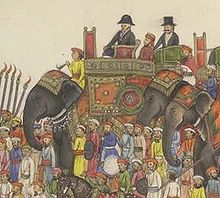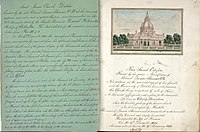
Bahadur Shah II, usually referred to by his poetic title Bahadur Shah Zafar, was the twentieth and last Mughal emperor and an Urdu poet. He was the second son and the successor to his father, Akbar II, who died in 1837. He was a titular Emperor, as the Mughal Empire existed in name only and his authority was limited only to the walled city of Old Delhi (Shahjahanbad). Following his involvement in the Indian Rebellion of 1857, the British deposed him and exiled him to Rangoon in British-controlled Burma in 1858, after convicting him on several charges. The title of Empress of India was subsequently transferred to Queen Victoria.

Akbar II, also known as Akbar Shah II, was the nineteenth Mughal emperor from 1806 to 1837. He was the second son of Shah Alam II and the father of Bahadur Shah II, who would eventually succeed him and become the last Mughal emperor.

Farrukhsiyar, also spelled as Farrukh Siyar, was the tenth Mughal emperor from 1713 to 1719. He rose to the throne after deposing his uncle Jahandar Shah. He was an emperor only in name, with all effective power in the hands of the courtier Sayyid brothers.

Mehrauli is a neighbourhood in South Delhi, Delhi, India. It represents a constituency in the legislative assembly of Delhi. The area is close to Gurugram and next to Vasant Kunj.

Ahmad Shah Bahadur, also known as Mirza Ahmad Shah or Mujahid-ud-Din Ahmad Shah Ghazi, was the fourteenth Mughal emperor, born to Emperor Muhammad Shah. He succeeded his father to the throne in 1748, at the age of 22. When Ahmed Shah Bahadur came to power, the Mughal Empire started to decline. Furthermore, his administrative weakness eventually led to the rise of the usurping Imad-ul-Mulk.

General Bakht Khan (1797–1859) was the commander-in-chief of the Indian rebel forces in the city of Delhi during the Indian Rebellion of 1857 against the East India Company.
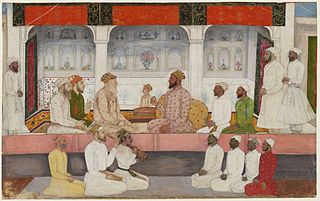
The term Sayyid brothers refers to Syed Abdullah Khan and Syed Husain Ali Khan, who were two powerful nobles during the decline of the Mughal Empire.

Company style, also known as Company painting is a term for a hybrid Indo-European style of paintings made in India by Indian artists, many of whom worked for European patrons in the East India Company or other foreign Companies in the 18th and 19th centuries. The style blended traditional elements from Rajput and Mughal painting with a more Western treatment of perspective, volume and recession. Most paintings were small, reflecting the Indian miniature tradition, but the natural history paintings of plants and birds were usually life size.

Sir Thomas Theophilus Metcalfe, 4th Baronet, KCB was an East India Company civil servant and agent of the Governor General of India at the imperial court of the Mughal Emperor Bahadur Shah Zafar.

Hafiz Rahmat Khan was the Regent of Rohilkhand in North India, from 1749 to 1774. He was a Pashtun by background, ruling over Rohillas. Hafiz Rahmat Khan had served honorably throughout the reign of three Mughal Emperors: Ahmad Shah Bahadur, Alamgir II and Shah Alam II. He was also a mentor of Prince Mirza Jawan Bakht.
Qutub Bakhsh, more commonly known as Tanras Khan, was an Indian musician of the Hindustani Classical tradition known for being a luminary of the Delhi Gharana.(House of Delhi classical musicians). He was a court musician and music teacher to the last Mughal emperor Bahadur Shah Zafar II.

The Mughal Empire had a number of imperial flags and standards. The principal imperial standard of the Mughals was known as the alam. It was primarily moss green. It displayed a lion and sun facing the hoist of the flag. The Mughals traced their use of the alam back to Timur.

Metcalfe House is the name given to two residential houses built in the 19th century in Delhi; one is near Old Delhi Civil Lines and the other is in Mehrauli, South Delhi. These were built by Sir Thomas Metcalfe (1795–1853), a civil servant, when he was the Governor General's last British resident (agent) at the Mughal court of Emperor Bahadur Shah Zafar.

Zafar Mahal, in Mehrauli village, in South Delhi, India, is considered as the last monumental structure built as a summer palace during the fading years of the Mughal era. The building has two components namely, the Mahal or the palace, which was built first by Akbar Shah II in the 18th century, and the entrance gate that was reconstructed in the 19th century by Bahadur Shah Zafar II, popularly known as "Zafar" meaning ‘Victory’. It has a forlorn history because Bahadur Shah Zafar, who wished to be buried in the precincts of the Zafar Mahal (palace) and the famous Dargah of Khwaja Qutubuddin Bakhtiar Kaki in Mehrauli, Delhi, was deported by the British to Rangoon, after the First War of Indian Independence in 1857, where he died of old age. The monument today is in a neglected and ruined state, locals play cricket and gamble freely inside the protected monument. The 18th-century palace has been all but subsumed by unauthorised constructions.

Feroze Jung III or Nizam Shahabuddin Muhammad Feroz Khan Siddiqi Bayafandi also known by his sobriquet Imad-ul-Mulk, was the grand vizier of the Mughal Empire when it was under Maratha suzerainty, making them the de facto rulers.
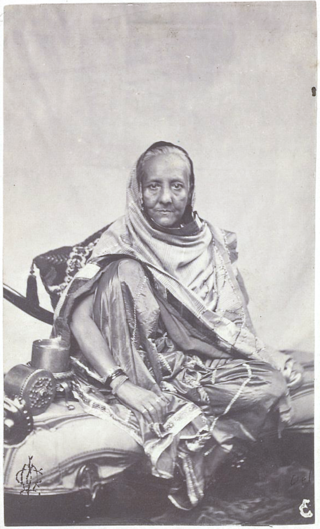
Zeenat Mahal was the only wife and de facto regent of the Mughal Kingdom on behalf of her husband, the Mughal emperor Bahadur Shah Zafar.
Ghulam Ali Khan was a nineteenth century Indian painter in Delhi. His painting career took place over the course of more than four decades, from 1817 to 1852. He was the last royal Mughal painter, and also painted in the Company style for British patrons.
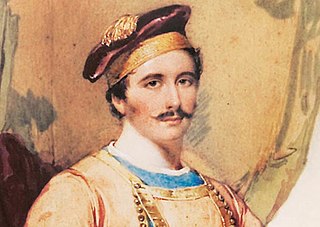
William Fraser was a British India civil servant who was an Agent to the Governor General of India and Commissioner of the Delhi Territory during the reign of the last Mughal Emperor, Bahadur Shah Zafar. He was a brother of James Baillie Fraser.

Mazhar Ali Khan was a late-Mughal era, 19th century painter from Delhi, working in the Company style of post-Mughal painting under Western influence. He was active from 1840, and is known for his noted work of topographical paintings commissioned by Sir Thomas Metcalfe's, Delhi Book.
The Indian Rebellion of 1857, which was also known as the Sepoy Mutiny or the First War of Independence, and was a significant uprising against British colonial rule in India from 1857 to 1858, was directed against the authority of the British East India Company, which acted as a self-governing entity on behalf of the British Crown. The rebellion originated on 10 May 1857 when sepoys, Indian soldiers, mutinied in Meerut, a garrison town northeast of Delhi. It quickly spread across the upper Gangetic plain and central India, with additional instances of revolt in the northern and eastern regions.
